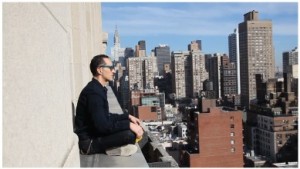 After tackling American maverick composer Charles Ives and receiving a Grammy Award nomination for it, vocalist Theo Bleckmann now takes on the mysterious songbook of British pop recluse Kate Bush. Beyond merely re-creating Kate Bush’s music, Hello Earth! The Music of Kate Bush (Winter & Winter) takes it into other realms of sound and interpretation.
After tackling American maverick composer Charles Ives and receiving a Grammy Award nomination for it, vocalist Theo Bleckmann now takes on the mysterious songbook of British pop recluse Kate Bush. Beyond merely re-creating Kate Bush’s music, Hello Earth! The Music of Kate Bush (Winter & Winter) takes it into other realms of sound and interpretation.
Bush’s œuvre is indeed mysterious and often enigmatic in nature: unusual song forms, oracular lyrics and unpredictable meter and harmony changes are an anomaly in pop music, making it the perfect vehicle for Bleckmann’s distinctive, interpretive spirit and interest in the unusual.
Kate Bush’s singular pop music is not your usual run-of-the-mill boy-meets-girl/boy-loses-girl fare. Her use of British and Irish myths, her references to psychology, literature and film, her meticulously multi-layered productions and her unusually high voice make her idiosyncratic body of work challenging for other artists to interpret.
Bleckmann first heard Bush as a young teenager and was immediately intrigued. “Her music has this thing that I love in art: you’re instantly drawn into someone’s universe without really knowing why but somehow understanding everything in your heart,” says Bleckmann.
A lot of teenage pop heroes came and went, but Kate Bush remained a constant in Bleckmann’s life. “Her songs and records never became obsolete. I now realize that the way she layered sound, speech and music became a major influence for my live electronic looping aesthetic.” For Hello Earth!, Bleckmann chose songs that warranted a different interpretation.
Hello Earth! is a journey into Kate Bush’s world through Bleckmann’s voice and interpretive vision. “Running Up That Hill,” which opens the record, gets a mysteriously ambient treatment. The lyric suggests switching gender in order to fully experience the other, which is where Bleckmann’s journey begins.
“Suspended in Gaffa”’s thumping waltz feel is now a suspended multi-metric virtuosic vehicle for the band, with Bleckmann proclaiming in jolting harming: “I want it all.” “And Dream of Sheep,” a song about being lost and shipwrecked at sea, turns into an ambient dream through Bleckmann’s use of vocal looping and Skuli Sverrison’s spherical bass playing then segueing into the unsettling “Under Ice,” a tale of entrapment under ice (am easy choice for Bleckmann, who was a competitive figure skater in his teens). “Violin” turns into a distorted death metal thrash, echoing the lyric’s destructive fierceness.
The title track, “Hello Earth,” keeps most of its original elements, including the inclusion of the Georgian folk song “Zinzkaro” in which the violin is now taking over the main melody while Bleckmann provides the harmony. “All the Love,” however, gets a more radical transformation, in which Bleckmann stretches the original melody and harmonies and inserts a vocalise into the middle. The last verse is delivered over a static vocal and violin loop, bringing out the song’s fragility and feeling of regret. Set in a Berlin bar, “Saxophone Song” probably gets the most jazz treatment, while “Army Dreamers” has been completely stripped of most of its original accompaniment and turned into an antiphonal drinking song as a lament over a lost generation of soldiers.
The record closes with Bush’s most well known (and covered) song, “This Woman’s Work.” Here, Bleckmann accompanies himself with looped voices leading us out of the initial gender switching in “Running up that Hill” to his exit by singing, “Make it go away, make it go away … now.” Bleckmann treats Bush’s music as he would that of Charles Ives, Thelonious Monk, George Gershwin, Guillaume de Machaut, Joni Mitchell or any other composer he takes on: with love, respect and an insatiable curiosity for new possibilities.
Joining Bleckmann in this venture are long-time collaborators including percussionist John Hollenbeck and electric bassist Skúli Sverrisson, and keyboardist Henry Hey and violinist/guitarist/vocalist Caleb Burhans, who can also be heard on Bleckmann’s Berlin album.
“When I set out to do this, I knew right away that these were the perfect musicians for this kind of project,” says Bleckmann. Hollenbeck, a brilliant composer and arranger of his own, contributed his vast orchestral palette and ideas to the music, including the use of crotales, which greatly shape the sound of this record. Sverrisson and Bleckmann also go back many years and have worked together in various configurations (including Laurie Anderson’s band). Sverrisson’s profound sense of sound and layering and his compositional instincts became essential to the music. Keyboard wizard (and newly appointed musical director for George Michael) Henry Hey, whom Bleckmann worked with here for the first time, contributed a vast array of sounds and possibilities, transforming and bringing to life Bleckmann’s initial ideas.
Caleb Burhans is perhaps one of the most sought after young musician/composers on the New York downtown scene today. “I wanted someone who could play many different instruments, loop, improvise and sing, which pretty much eliminated everyone but Caleb. For the recording I chose to overdub myself and add more harmonies, but in performance Henry Hey and Caleb Burhans play and sing.”
Theo Bleckmann’s Upcoming Shows:
February 22: Theo Bleckmann meets Michael Wollny, Joe’s Pub, NY
February 27: w/ John Hollenbeck’s Claudia Quintet, Yoshi’s, San Francisco, CA
February 28: w/ John Hollenbeck’s Claudia Quintet, Blue Whale, LA
February 29: w/ John Hollenbeck’s Claudia Quintet, Cal State Fullerton New Music Festival
March 1: w/ John Hollenbeck’s Claudia Quintet, 560 Music Center, St Louis, MO
April 7: Hello Earth! CD Release, Highline Ballroom, New York, NY
April 12-15: Phil Kline’s ZIPPO SONGS, UC Davis, CA



